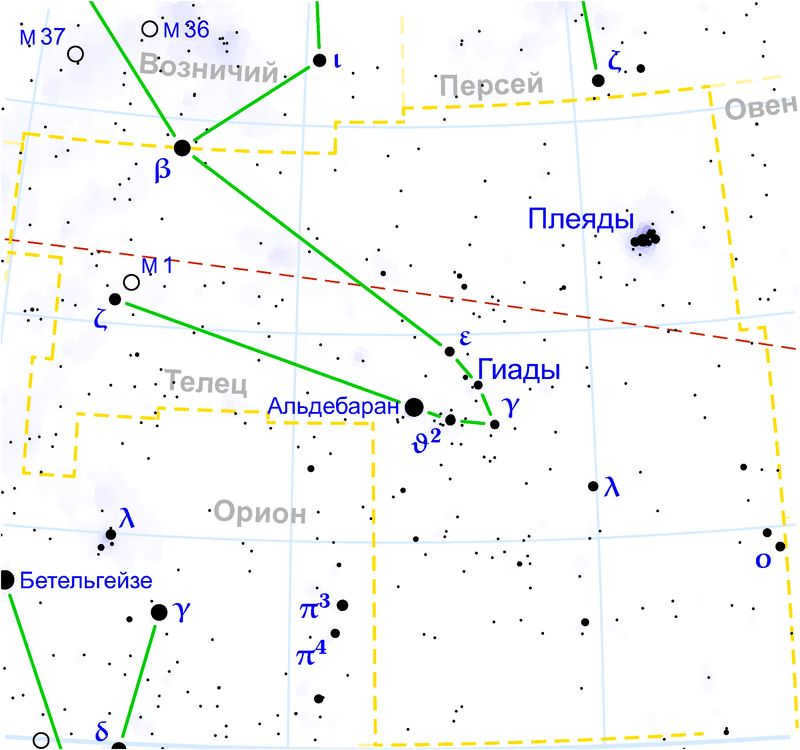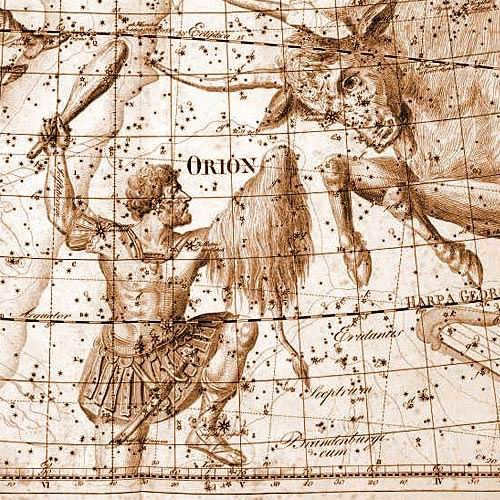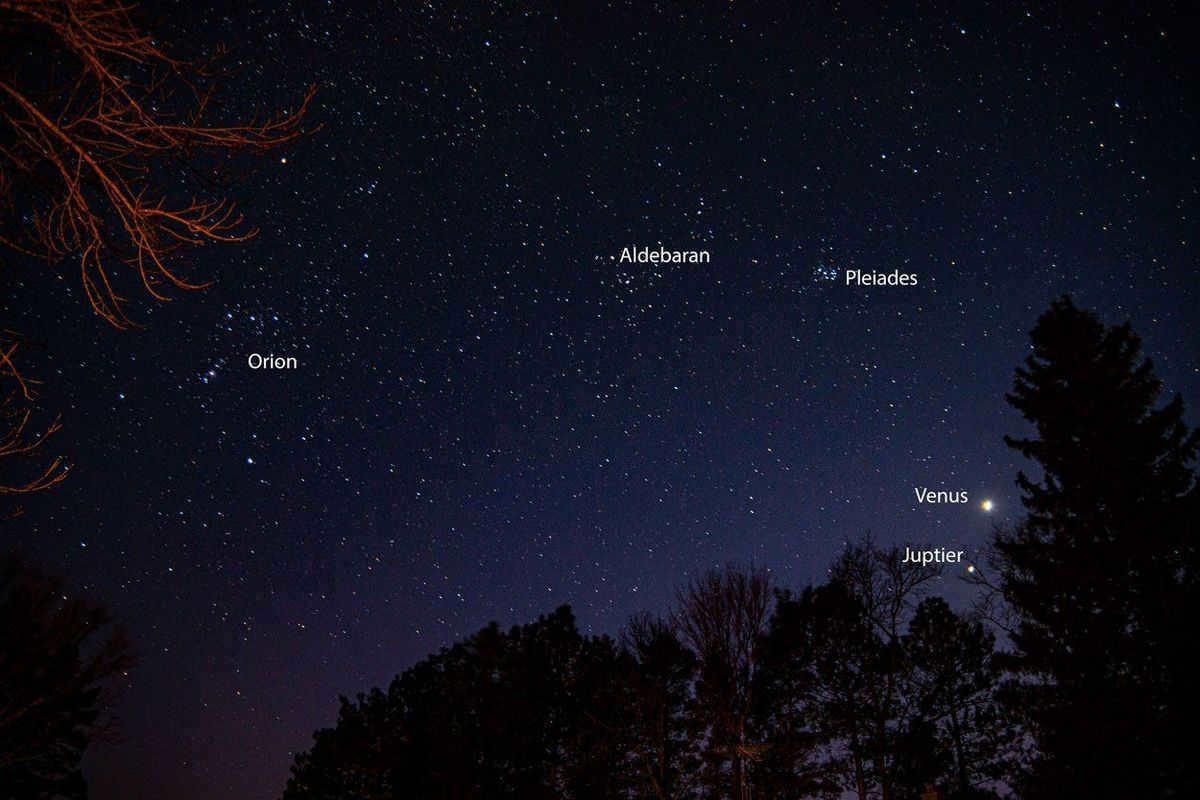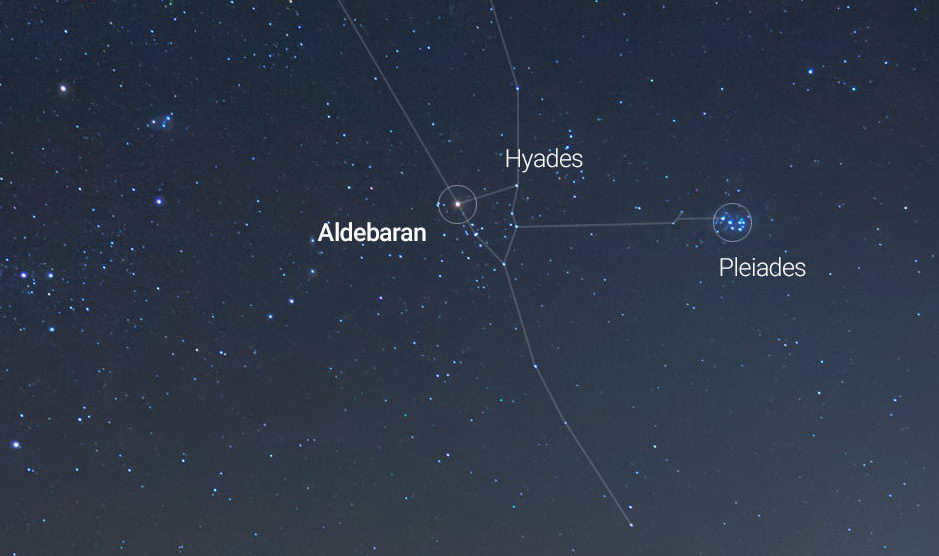
Aldebaran, a star that shines brightly in the northern hemisphere, is easily visible when gazing at the night sky. Throughout history, people from various cultures have attributed numerous legends and myths to this captivating celestial entity.

Aldebaran’s Position in the Night Sky
The celestial body Aldebaran can be found within the constellation known as Taurus, which belongs to the Zodiac. Ancient star maps, which depicted constellations as animals or heroes, consistently portray Aldebaran as the eye of a bull. The Persians classified it as one of the Royal Stars, a group of four stars considered to be the guardians of the sky. The other three stars in this category are Antares, Famalgaut, and Regulus. While Aldebaran appears as the brightest star within the Hyades cluster in the night sky, it is actually much closer to Earth. This star is approximately sixty light-years away from our Sun. Due to the way the sky appears from our perspective, Aldebaran seems to blend in with the Hyades cluster, giving the appearance that it is part of the cluster. Aldebaran is actually a binary star system, meaning it consists of two stars that are gravitationally bound to each other. The companion star is a red dwarf, categorized as a spectral class M2. The distance between these two stars is several hundred astronomical units. Interestingly, Aldebaran and its companion are relatively isolated in space, with no nearby stars within a distance of more than twenty light-years, making them like an island in the vastness of the universe.
Aldebaran, a star in the sky, has an Arabic name. The reason for this is that during the Middle Ages, astronomy flourished mainly in the East while Europe was experiencing the Dark Ages. The Arabs, building upon the knowledge of the ancient Greeks and Romans, made significant contributions to the field. One of their achievements was the translation of Claudius Ptolemy’s book, which was originally written in 140 AD and described over 1,000 stars. The Arabs translated this work and added their own discoveries, enriching it further. By the time astronomy was reintroduced in Europe, Ptolemy’s knowledge had already become part of a larger work known as the Almagest.
The name Aldebaran in Arabic translates to “following”. This name is derived from the fact that it is a star that travels across the sky. It is also known as the Bull’s Eye, as it holds a prominent position in the constellation of Taurus. The Greeks referred to Aldebaran as Lamparus, while the Romans called it Palilius. Both of these names signify a torch that shines in the night sky. In the ancient Persian kingdom, this star was documented over 3,000 years before the birth of Christ.
Physical attributes

Satellites of Aldebaran


In 1993, a significant discovery was made when scientists detected long-period fluctuations in the radiation emitted by Aldebaran. This finding was interpreted as evidence of the presence of a substellar object located 1.35 astronomical units away from the star. This object could potentially be a brown dwarf or a gas giant, with a mass exceeding 11 times that of Jupiter.
Subsequently, in 2015, researchers announced the detection of another exoplanet within the Aldebaran system. This planet is estimated to be approximately 6.5 times the size of Jupiter and completes a full orbit around its star in a period of about 700 Earth days. It is most likely a hot gas giant.
The Aldebaran system also includes a second star known as Aldebaran B, which is classified as a dim red dwarf of the M2 spectral type.
Comparing the brightness of stars

A significant factor that distinguishes stars from one another is their luminosity. Luminosity refers to the quantity of radiation that a star emits out into space. To better understand this concept, let’s compare the luminosities of Aldebaran, Regulus, Sirius, and the Sun. Aldebaran has a luminosity of 153L, Regulus has a luminosity of 288L, Sirius has a luminosity of 22L, and the Sun has a luminosity of 1L. The unit L represents the amount of energy that the Sun releases and is commonly used by astronomers as a reference point.
Observing Aldebaran: How and When
If you want to observe the star Aldebaran, the winter season is the best time to do so. Fortunately, locating the star is quite straightforward. You just need to visualize a line passing through the three bright stars that make up Orion’s belt, from left to right. By extending this line, you will find Aldebaran as the first star in its path. Additionally, in the sky, you can also spot a scattered cluster of stars known as Hyades, which is located in the constellation of Taurus. However, it’s important to note that the Hyades appear to be close to Aldebaran, but in reality, they are actually 150 light-years away from Earth, making them nearly two and a half times more distant. The Bull’s Eye is merely projected onto their luminosity.
Legends and myths

Interesting tidbits


Today you will gain some knowledge about Aldebaran, an orange-red giant that “chases” the Pleiades across the nighttime sky.
Information about Aldebaran
Aldebaran stands out as the most brilliant star in the Taurus constellation. This celestial entity serves as a prime example of a typical red giant. Such stars are truly fascinating for numerous reasons. For instance, unlike the Sun, which undergoes hydrogen fusion to form helium in its core, our protagonist has already exhausted its hydrogen reserves. Consequently, its outer layer has expanded. The remaining hydrogen is still undergoing conversion into helium, albeit at a significantly slower rate.
While the serene center of the red giant keeps contracting, its hydrogen layer keeps expanding. Consequently, Aldebaran has grown to be 44 times larger than the Sun. Nevertheless, remarkably, the masses of these stars are approximately equal. Hence, the outer hydrogen envelope of the orange star is significantly less dense than that of the Sun. An accompanying result of this expansion is an increase in the brightness of the red giant. Aldebaran radiates with a luminosity of no less than 450 Suns.
A fiery orange star
However, the temperature of this star is perhaps its most fascinating characteristic (and certainly the most apparent to us earthlings). It is what imparts the giant with its stunning hue. Nevertheless, despite Aldebaran’s reddish appearance, it is not a hot star. In actuality, it is quite the opposite. While the Sun’s surface temperature reaches approximately 5,500 °C, Aldebaran is significantly cooler. Its surface is heated to a mere 3,700 °C.
The orange giant we are discussing today could potentially be a member of a multiple star system. Based on information provided by the Gaia space telescope of the European Space Agency, it appears that there is at least one small celestial object in orbit around this star. Aldebaran is also a potential host star for the massive exoplanet Aldebaran b. If this exoplanet does indeed exist, it would be approximately six times the size of Jupiter. However, it is also possible that the stellar activity is merely imitating a planetary signal.
The term Aldebaran is derived from the Arabic term al Dabaran, which signifies “follower.” The designation could be linked to the star’s position in the sky, situated behind the Pleiades, as if it is “following” them throughout the sky.

Aldebaran, the brightest star in the Taurus constellation, was historically associated with the bull’s eye due to its orange-red color. Taurus has been recognized as a constellation for thousands of years, with these associations dating back to the Mesopotamian era of Gilgamesh, making them at least 4,000 years old.
The ancient Greeks, Egyptians, Babylonians, and Romans also shared the belief in Taurus the Bull. However, in some Native American cultures, Taurus represented the head of a buffalo rather than a bull. Furthermore, the Inuit people of the Arctic saw Aldebaran as a polar bear, demonstrating different cultural interpretations.
Taurus appears to be moving eastward towards Orion, suggesting a potential confrontation. This dynamic is reflected in various ancient myths and legends.

Aldebaran is a star that exhibits slight variations in brightness over a relatively long period of time, which might have been documented in the legends of indigenous Australian people.
The Pioneer 10 spacecraft, operated by NASA, is currently following a trajectory that, if undisturbed, will bring it close to Aldebaran in millions of years.
Guide to Observing Aldebaran

Aldebaran, the 14th brightest star in the night sky, can be easily located in the correct part of the sky. Its reddish color serves as a helpful clue for beginners in astronomy. However, the best way to find Aldebaran is to look between two well-known celestial objects: the constellation Orion and the Pleiades star cluster. Additionally, the three-star line of Orion’s belt roughly points towards Aldebaran, although the alignment is not exact.
Aldebaran is considered an honorary member of the Hyades star cluster because it appears to be in the middle of it from our perspective. However, this is only a line-of-sight effect, as Aldebaran is actually much closer to Earth than the Hyades.
Due to its proximity to the ecliptic, Aldebaran frequently finds itself in the company of the Moon and other planets, which can sometimes overshadow the star in astronomical terms.

Several decades have elapsed since the conclusion of World War II. Over this period, a mythology has developed, intertwining various tales concerning the activities of the Nazis and their allies. Upon reading certain narratives, one occasionally experiences the sensation that they are so outlandish that they resemble the plotlines of adventure films. The plethora of stories surrounding the Nazis and their involvement with the supernatural, UFOs, and the occult is countless. However, there are several particularly intriguing ones among them. Today, we will delve into one of these legends in detail. According to this myth, a psychic once received a blueprint of a spaceship.
In 1919, a beautiful young lady by the name of Maria Orsic arrived in Munich to reunite with her beloved. The couple aspired to tie the knot and embark on a fresh chapter together in Germany. Maria, born in 1895 in Zagreb, Croatia, had already gained considerable fame as a renowned medium by the time she immigrated. She possessed a remarkable ability to enter a profound state of trance and channel the voices of spirits, summoned at the behest of her patrons.

Maybe it was this enigmatic ability that quickly caught the girl’s attention to a group known as the Thule Society. And it altered her life forever…
The Thule Society, named after a mythical land from Greek mythology, was a secret organization with a focus on the occult. This clandestine society was established after the conclusion of World War I. Its members were primarily recognized for their extremely radical racial theories. They delved into the origins of the Aryans and sought to demonstrate, by any means necessary, the superiority of the Aryan race over all others.
An offshoot of this organization was the Vril Society, which Orsic eventually joined. It was there that she gained a reputation as a remarkably powerful psychic.
Aldebaran. The Birthplace of the Aryan Civilization
It all began with a séance in 1924. During this extraordinary event, Orsic attempted to establish a connection and communicate with the departed German anti-Semitic folk poet, playwright, journalist, publicist, and political activist, Dietrich Eckhart. It is said that she successfully made contact with Eckhart’s spirit and even started speaking in his voice, narrating a rather peculiar tale. The spirit requested permission to convey a message from an unidentified entity.
And so, Orsic began to transmit enigmatic information. According to the mysterious entity, the ancient Sumerians were, in fact, an extraterrestrial race originating from a planet near the star Aldebaran. These beings are believed to be the direct ancestors of the Aryan civilization. Supposedly, these extraterrestrial visitors arrived on Earth around 500 million years ago…
Orsic later asserted that during the session, extraterrestrial beings transferred the blueprints for a spacecraft with the capability of executing “interdimensional leaps” directly into her mind. Remarkably, she was able to transcribe these plans onto paper. Allegedly, the spacecraft was even constructed!
The Psychic Medium maintains that in 1943, a gathering took place between representatives from Vril and Thule. The objective of this meeting was to strategize the logistics of journeying to the Aldebaran system. The purpose of the expedition was to establish contact with their forefathers beyond our own world.
They departed
Nevertheless, the course of events did not unfold as intended. This was due to the alleged concern within the Vril society that the SS had managed to infiltrate their ranks. Consequently, the leaders of the Vril society were unwilling to allow the spaceship to fall into the hands of the Third Reich. As a result, they either concealed or destroyed the ship along with all its blueprints. Subsequently, the Vril Society was disbanded…
after which its members vanished without a trace, leaving behind only speculation that they employed the ship they had created and journeyed to the Aldebaran system.
However, it is believed that the SS managed to recover a portion of the extraterrestrial blueprints, which they then utilized in their exploration of UFO technology…
We can only ponder whether this extraordinary narrative holds any truth, or if it is merely one of the peculiar legends entwined with Nazi activities.

Aldebaran, the brightest star in the Zodiac, is situated in the constellation Taurus. Throughout history, it has been known by various names, including “Lamparus” (meaning “lighthouse” in Greek), “Royal Star” by the Persians, “Heart of the Bull” by the ancient Chinese, and “Bagpiper” by the Bulgarians. The Arabic name “Aldebaran” translates to “follower.”
From November to January, when the constellation Taurus is at its highest point above the horizon, Aldebaran can be easily observed with the naked eye in the night sky.
Main characteristics
- Astronomers describe Aldebaran as a “typical orange giant,” a variable star with a small range of brightness.
- It has an estimated age of 6.6 billion years.
- Aldebaran is located approximately 20 parsecs or 65 light-years away from Earth (precise measurements were obtained in 1989 using the Hipparcos satellite telescope, which was in orbit for 37 months).
- Its mass ranges from 1.13 to 2.5 times that of the Sun.
- The star has a radius of about 44 times that of the Sun.
- Its surface temperature is around 3,600 degrees Celsius.
- Aldebaran has a metallicity of 70%.
- It has a rotational velocity of 4.3 kilometers per second.
- The star’s own motion is measured at 58.39 kilometers per second, providing information about its distance from the solar system.
- The radial velocity of Aldebaran is 53.8 km/sec.
Luminosity
As per the findings of the Hipparcos telescope, Aldebaran shines with a luminosity that is 439 times greater than that of the Sun. However, due to its significant distance and limited visibility, it only ranks 14th among the celestial bodies in terms of apparent magnitude in the night sky.
This star derives its energy from the burning of helium, as all the hydrogen within it has already been consumed.
It is predicted that in a few million years, the luminosity of Aldebaran will exceed that of the Sun by a staggering 800 times.
Interesting facts about the celestial body Aldebaran
1. The visually striking formation of the letter “V” can be observed using binoculars or even with the naked eye. This formation is created by four stars from the Hyades cluster, which is one of the closest star clusters to Earth.
2. On June 1st each year, there is a unique event where the Sun and Aldebaran appear to merge into a single visible point.
3. Occasionally, the Moon passes in front of Aldebaran, resulting in an overlapping effect. The most recent recorded occurrence of this phenomenon took place in August 2017 during daylight hours.
4. The Pioneer-10, a small spacecraft that was launched towards Aldebaran in the 1970s, is still within our solar system. It has been over 10 years since we last communicated with it. On board, there is a message containing information about the Solar System and Earth, potentially for an alien civilization on Aldebaran. At its current velocity, Pioneer-10 could reach its destination in approximately 2 million years.
*** I can’t help but wonder if the individuals behind these space “gifts” have considered the consequences if this message were to be intercepted by a highly advanced civilization with malicious intentions towards Earth. Our nuclear weapons would be as insignificant as a mosquito’s squeak.
5. Since 1997, the presence of a gas planet (brown dwarf) that weighs more than eleven times the mass of Jupiter and affects the orbits of Pollux and Arcturus has been postulated.
6. Aldebaran is a member of the Winter Circle, a seasonal asterism that is most visible near the equator.
7. It is often referenced in works of fantasy and their film adaptations, such as Tolkien’s Lord of the Rings and the novels of Kir Bulychev.
8. The Babylonians used the position of Aldebaran in the sky to mark the beginning of the new year.
10. The astrologers of Persia (3000 years ago) believed that Aldebaran, along with Regulus, Antares, and Fomalgaut, served as one of the celestial guardians at the eastern gates of heaven.
11. It is predicted that Aldebaran’s life cycle will come to an end in the next 2 billion years, causing it to transform into a white dwarf once it depletes its helium supply.
Aldebaran (α Tau / α Taurus / Alpha Taurus) is the most luminous star in the Taurus constellation and the entire Zodiac. It is also one of the brightest stars visible in the night sky. Its name originates from the Arabic word الدبران (al-dabarān), which means “follower” – as the star follows the Pleiades in its celestial journey. Due to its location in the head of Taurus, it is referred to as the Eye of Taurus (Lat. Oculus Taurī). It is also known by the names Palilius and Lamparus.
Essential details
In terms of appearance, Aldebaran is visually perceived as the most radiant constituent of the dispersed star cluster known as the Hyades, which is the nearest star cluster to our planet. Nevertheless, it is positioned at a closer proximity compared to the cluster itself, forming a direct line connecting Earth and the Hyades. In reality, Aldebaran is essentially a star that extends into the cluster.
Aldebaran, an orange star classified as a K5 III, belongs to the category of normal giants. It is accompanied by a red dwarf of the M2 class, located a few hundred a.f.e. away. The main component of the system is currently burning mostly helium and has expanded to a size of approximately 5.3-10 7 km, which is equivalent to about 38 solar diameters [source not provided for 533 days]. The Hipparcos satellite has measured the distance from Earth to Aldebaran as 65.1 light-years, with a luminosity 150 times greater than that of the Sun. Considering this distance and brightness, Aldebaran ranks 14th in terms of apparent luminosity, with a magnitude of 0.85. It is a variable star with a small amplitude of luminosity (about 0.2 magnitude) and exhibits irregular variability.
Back in 1997, there was a report suggesting that there might be a companion to Aldebaran – a massive planet (or perhaps a small brown dwarf) with a mass equal to 11 times that of Jupiter, located at a distance of 1.35 astronomical units.
Finding Aldebaran in the night sky is a relatively easy task, thanks to its brightness and its position relative to one of the most recognizable collections of stars in the sky. By mentally connecting the three stars of Orion’s Belt from left to right (for observers in the northern hemisphere) or right to left (for observers in the southern hemisphere), you can easily spot Aldebaran as the first bright star that continues the imaginary line.
Interestingly, the unmanned Pioneer-10 spacecraft is currently on a trajectory that will eventually lead it towards Aldebaran. If all goes well and no unforeseen events occur, the spacecraft is expected to reach the vicinity of the star in approximately 2 million years.
Aldebaran in the world of scientific fiction
- Aldebaran in the works of Stanislav Lem In Stanislav Lem’s works, specifically in the cycle “The Adventures of Ion the Silent” (in the story “Journey Twenty-Eighth”), there is a star system that is suitable for habitation. The civilization in this star system is slightly less advanced than that of Earth in terms of rocket science. The story mentions the United Aldebaran Shipyards, who have named their first edible three-stage rocket (Appetizers-Fried-Desserts) after Aristarchus Felix Tycho, Ion Tycho’s cousin.
- In the game Starmageddon 2, the main character travels through a hyperspace portal and arrives in the constellation Taurus near Aldebaran, where they are immediately attacked by Aldebarans.
The immediate vicinity of the star
Within a distance of 20 light years from Aldebaran, the following star systems can be found:
| Star | Spectral class | Distance, sv. years |
| VA 366 | M0 V | 4.4 |
| Ross 388 | M3 V | 9.1 |
| BD+16 527 | G0-5 V | 12 |
| BD+05 614 | G0 IV | 14 |
| BD+05 613 | G5 IV | 14 |
| 39 Taurus | G5 V / ? | 14 |
| 104 Taurus | G4 V / ? | 16 |
| BD+27 688 | K3-5 III | 16 |
| LTT 17742 | G V | 18 |
| BD+23 548 | F6 V | 19 |





